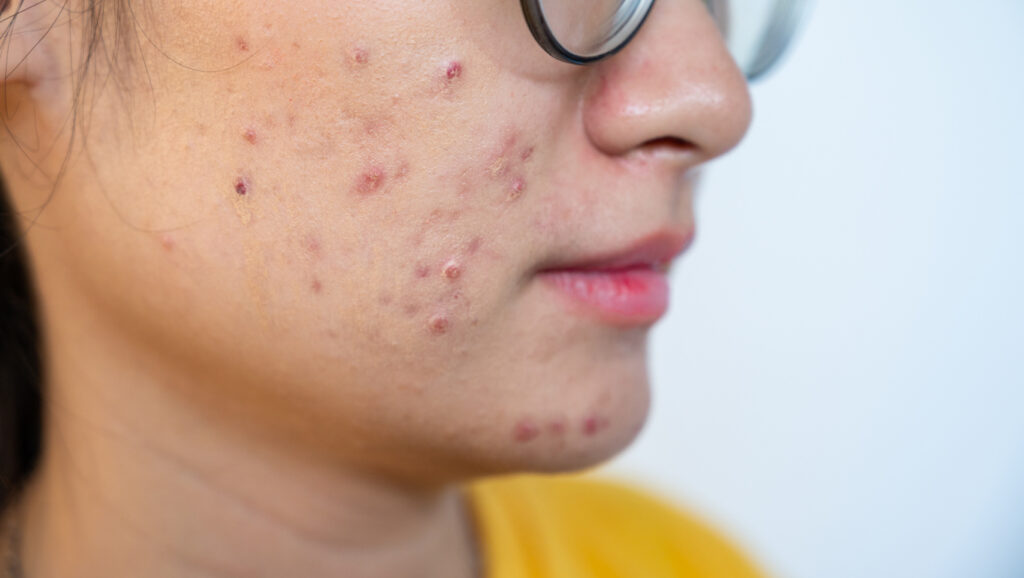Denifanstat (ASC40), a first-in-class, once-daily oral small molecule fatty acid synthase (FASN) inhibitor, met all primary, key secondary, and secondary endpoints in a Phase 3 clinical trial for the treatment of moderate-to-severe acne vulgaris, Ascletis Pharma Inc. reports.
The mechanisms of action of denifanstat for the treatment of acne are (1) direct inhibition of facial sebum production, through inhibition of de novo lipogenesis (DNL) in human sebocytes; and (2) inhibition of inflammation, through decreasing cytokine secretion and Th17 differentiation.
Denifanstat’s mechanism of action directly reduces one of the main underlying causes of acne: the overproduction of sebum.
Phase 3 Trial in China
The Phase 3 clinical trial was a randomized, double-blind, placebo-controlled, multicenter clinical trial in China to evaluate the safety and efficacy of denifanstat once-daily oral tablet in 480 patients with moderate-to-severe acne vulgaris. Patients were enrolled and randomized into one active treatment arm and one placebo control arm at the ratio of 1:1 to receive 50mg denifanstat oral tablet once daily or matching placebo for 12 weeks. Baseline characteristics were well-balanced between denifanstat and placebo arms.
Primary endpoints included the percent treatment success (defined as an Investigator’s Global Assessment (IGA) score of 0 (clear) or 1 (almost clear) with at least a 2-point decrease in IGA from baseline at Week 12), the percent reduction from baseline in total lesion count, and the percent reduction from baseline in inflammatory lesion count. At Week 12, percent treatment success was 33.2% compared to 14.6% for placebo, percent reduction from baseline in total lesion count was 57.4% compared to 35.4% for placebo, and percent reduction from baseline in inflammatory lesion count was 63.5% compared to 43.2% for placebo. The key secondary endpoint, percent reduction from baseline in non-inflammatory lesion count at Week 12, was 51.9% compared to 28.9% for placebo.
Favorable Safety and Tolerability Profile
Denifanstat demonstrated a favorable safety and tolerability profile following 12 weeks of once-daily oral administration at 50 mg. The incidence rates of treatment-emergent adverse events (TEAEs) were comparable between denifanstat and placebo. No incidence rates of TEAEs related to study drug in any category exceeded 10%. Only two categories of TEAEs had an incidence rate of more than 5% (6.3% dry skin in denifanstat-treated patients versus 2.9% in the placebo group; 5.9% dry eye in denifanstat-treated patients versus 3.8% in the placebo group). All denifanstat-related adverse events (AEs) were mild or moderate. There were no denifanstat-related grade 3 or 4 AEs and no denifanstat-related serious AEs (SAEs). No deaths were reported.
Denifanstat demonstrated its exceptional efficacy across multiple key metrics compared to sarecycline, doxycycline and clascoterone cream. With regard to the placebo-adjusted percent treatment success and the placebo-adjusted percent reduction from baseline in inflammatory lesion count, denifanstat was 98% and 30% more effective than sarecycline, respectively, 178% and 178% more effective than doxycycline, respectively, and 60% and 59% more effective than clascoterone cream, respectively.
Regarding the placebo-adjusted percent reduction from baseline in total lesion count, denifanstat was 189% and 85% more effective than doxycycline and clascoterone cream, respectively. With regard to the placebo-adjusted percent reduction from baseline in non-inflammatory lesion count, denifanstat was 411% and 102% more effective than sarecycline and clascoterone cream, respectively.
Significant Improvements
“The data demonstrate statistically significant improvements in treatment outcomes for moderate-to-severe acne patients, with percent treatment success of 33.2%, total lesion count reduction of 57.4% from baseline, inflammatory and non-inflammatory lesion counts decreasing by 63.5% and 51.9%, respectively, while maintaining a favorable safety and tolerability profile,” says study author Prof. Leihong Xiang, Chief Physician of Dermatological Department, Huashan Hospital, Fudan University, Executive Deputy Director of Institute of Dermatology, Fudan University, Deputy Director of Dermatology Division of Chinese Medical Doctor Association, in a news release. “Denifanstat’s first-in-class mechanism targeting FASN directly addresses a key cause for acne, establishing it as a groundbreaking therapeutic approach in acne treatment.”


